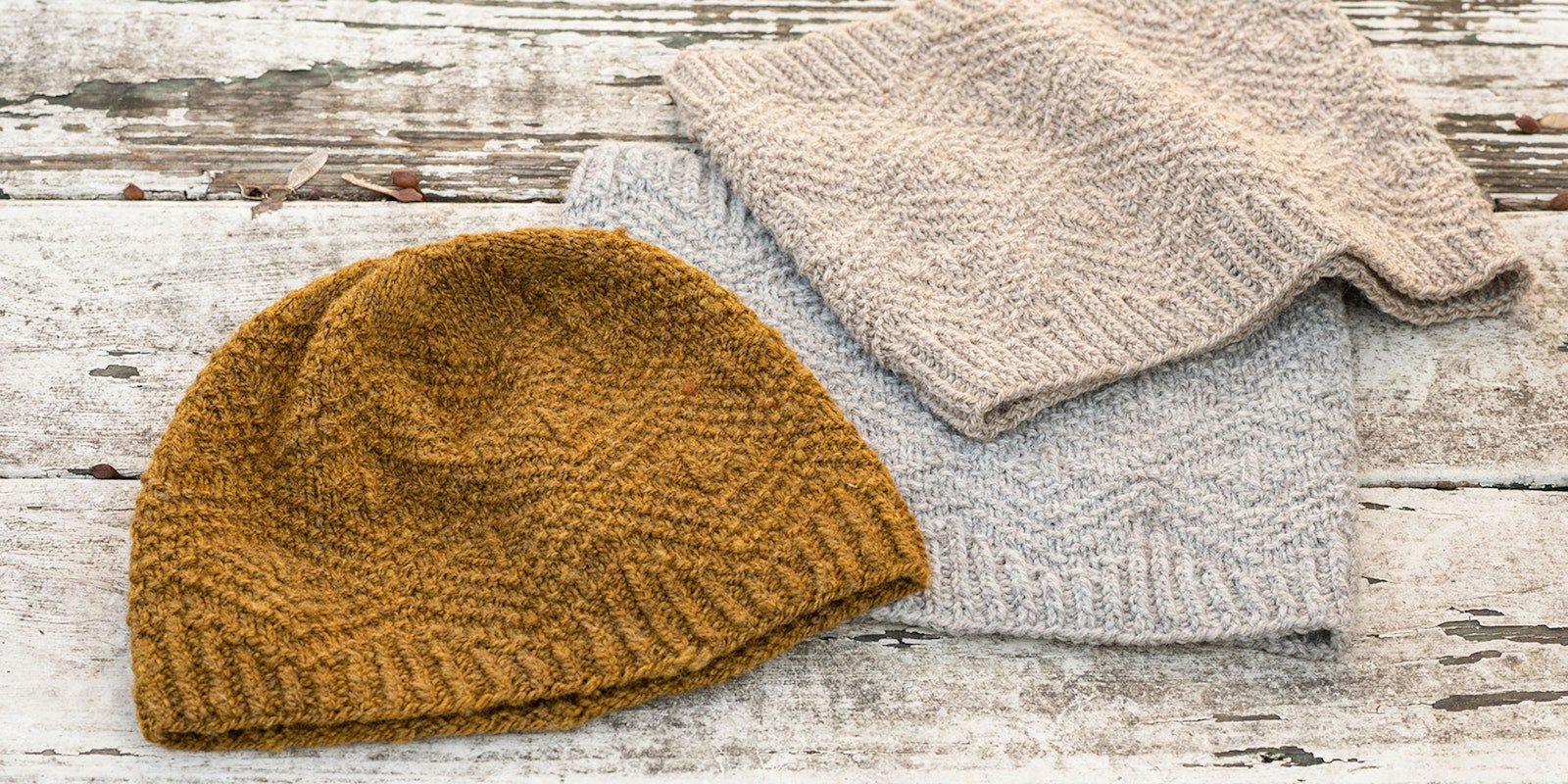Have you heard about our new sister community Farm & Fiber Knits? To celebrate the launch of FFK, we selected a great new pattern from its library to share with our subscribers in Spin Off Summer 2024. Sarah keeps a flock Cheviot and crossbred sheep on San Juan Island, and we asked her to share a bit about spinning bouncy wools for textured knitting. — Editors
I designed the Woolgrowers set thinking of small-batch farm yarns a knitter might encounter at a fiber festival or farmers market. But they’re also good small projects for handspun yarn, if you set yourself up for success with the right fiber and structure.
The motif for Woolgrowers is adapted from a traditional Danish motif I encountered in Vivian Høxbro’s research on the patterns of nineteenth-century nattrøjer, knitted woolen “night shirts” that were decorated with elaborate textural stitchwork despite their humble purpose as underlayers or sleepwear that wouldn’t have been seen in public. It’s a lattice of purl stitches framing purl diamonds split up the middle with a column of twisted knits, and the impact of the design comes from bold relief in the texture. To heighten that contrast between knits and purls, you’ll want to spin a round and bouncy three-ply yarn.
 For the motif to read clearly, you’ll want to stick to solid or nearly solid colors. Photo by Gale Zucker
For the motif to read clearly, you’ll want to stick to solid or nearly solid colors. Photo by Gale Zucker
One of the yarns I selected for my Farm & Fibers Knits samples was my own Grey Haven DK. This yarn, first created by Abundant Earth Fiber and now spun by Skagit Woolen Works, uses wool from our flock of North Country Cheviot sheep (and a couple of their crossbred offspring who have black fleeces from a Bluefaced Leicester x Romney x Coopworth parent). Cheviots are among the roundest and bounciest sheep on the planet, and their lofty, cloud-like lock structure is perfectly suited for yarns that show off cabled and textured fabrics. Typically raised for meat in North America, this breed is often overlooked as a source of handspinning fiber, which is a shame, as it winds up being a surprise favorite for many spinners who get the chance to sample it.
 The Oak Knoll Farm mixed-breed fiber flock grazing fresh pasture on San Juan Island. Photo by Sarah Pope
The Oak Knoll Farm mixed-breed fiber flock grazing fresh pasture on San Juan Island. Photo by Sarah Pope
As long as the fleece has been well skirted to remove coarse britch fibers from their weatherproof hindquarters, Cheviots provide a surprisingly soft wool with a 4"–5" staple and a micron count in the mid to upper 20s. If you’re able to wear medium wools next to your skin, this fiber is an enjoyable one to spin for the Woolgrowers Hat or Cowl. As Deborah Robson and Carol Ekarius describe it in The Fleece & Fiber Sourcebook, “Cheviot wool feels friendly.” And as a naturally felt-resistant breed, Cheviot will hold up well to the friction of wear against a coat collar. Planning for a three-ply structure allows you to keep the twist gentle in the singles, which will enhance the softness of the fibers and give their three-dimensional crimp the latitude to express its natural loft. Any of the Down breeds like Dorset, Suffolk, or Southdown will also make a good yarn with bounce and body for this pattern. If you require a finer wool for sensitive skin, Cormo, Polwarth, and Polypay come to mind as engaging fibers to try.
 A lock of North Country Cheviot fleece with skeins of DK/light worsted–weight yarn spun from the same fiber and a sample of the Woolgrowers Cowl. Photo by Sarah Pope
A lock of North Country Cheviot fleece with skeins of DK/light worsted–weight yarn spun from the same fiber and a sample of the Woolgrowers Cowl. Photo by Sarah Pope
For this rather delicate motif to read clearly, you’ll want to stick to solid or nearly solid colors—the visual business of a strongly marled yarn will obscure the pattern. Spinning the fiber worsted will create a smooth yarn with superior stitch definition, but you may prefer the softer, lived-in look a woolen preparation will lend to the textured fabric. Cheviot wool is particularly versatile, is easy to card or comb, and drafts smoothly. You may want to sample several preparations and see which is your favorite. If you’re working from a raw fleece, keep a weather eye for second cuts; the Down-type wools really like to hang on to them and it’s difficult to shake them free of the fleece during skirting. Expect a Cheviot yarn to fluff up a lot in finishing.
 Sarah, wearing a cabled sweater knit from her North Country Cheviot-cross yarn, with a group of Northie youngsters. The sweater pattern is Farm Chores by Samantha Guerin. Photo by Adam Greene
Sarah, wearing a cabled sweater knit from her North Country Cheviot-cross yarn, with a group of Northie youngsters. The sweater pattern is Farm Chores by Samantha Guerin. Photo by Adam Greene
The Woolgrowers set is written for a DK/light worsted yarn, but the nice thing about a cowl is that a little variation in size won’t matter. Plan to spin about 4.5 oz of fiber if you want to knit both the hat and cowl. I hope you enjoy this project and spin with visions of stout, bouncy sheep in mind.
Learn more about the Woolgrowers Hat & Cowl on the Farm & Fiber Knits website.
Find the pattern in the Summer 2024 issue of Spin Off magazine, or in the Farm & Fiber Knits Library.
Sarah Pope designs knitwear and runs a tiny wool company from her family’s sheep farm on San Juan Island, Washington. She is also the market manager for an interisland food hub and sings soprano in three community choirs. Find her online at San Juan Woolworks.

